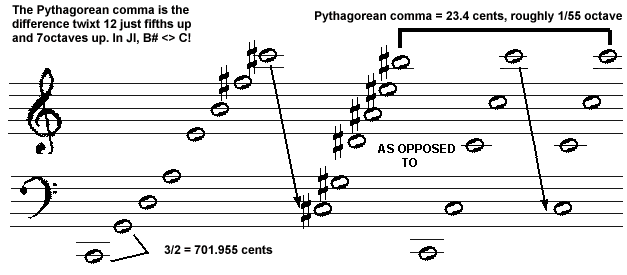Commas are small musical intervals between a note formed by one cycle of just intervals and the same note formed by another cycle of different just intervals. These commas prove important in constructing musical scales, and in notating musical chords and musical pitches.
The Pythagorean comma is the difference between 12 just
perfect fifths up and 7 octaves up:
[from Brian McLaren]
McLaren's description can be shown in both
vector notation and
in regular fractional math thus:
The ratio 531441/ 524288, in
JustMusic prime-factor notation
designated as 312, with an
interval size of approximately 0.23 Semitones
[= 23.460+ cents].
It is the difference between the
Pythagorean or 3-Limit
"tritone"
or "augmented 4th" of approximately 6.12 Semitones
[= 729/512 = 36 = 611.730+ cents] and the
Pythagorean or 3-Limit
"diminished 5th"
of approximately 5.88 Semitones [= 1024/729 = 3-6 = ~588.2699948 cents],
shown below in both
vector notation and
in regular fractional math:
It was first described c. 300 BC by pseudo-Euclid in Divisions of
the Canon.
Below are some other interval measurements for the Pythagorean comma:
[from Joe Monzo,
JustMusic:
A New Harmony]
updated:

2 3
[-12 12] (3/2)12 = 312/212 = 531441/4096 531441/4096 12 "5ths"
- [ 7 0] ÷ (2/1)7 = 128 * 1/128 7 "8ves"
----------- = --------- = ---------------
[-19 12] 531441/524288 Pythagorean comma
for C = n0 = 1/1 :
2 3
[ -9 6] (9/8)3 = 93/83 = 729/512 729/512 tritone: F:B
- [ 10 -6] ÷ (223-1)/(2-835) = (4/3)/(243/256) = 1024/729 * 729/1024 "diminished 5th": B:F
---------- = --------- = -------------
[-19 12] 531441/524288 Pythagorean comma
~0.234600104 (~1/4) Semitone
~1.407600623 (~1 2/5) 72edo-moria
~5.865002596 (~5 6/7) savarts
12 grads
~14.27150632 (~14 1/4) 730edo Woolhouse-units
~19.55000865 (~19 5/9) milli8ves
~20.72300917 (~20 5/7) Türk cents
~23.46001038 (~23 1/2) cents
~588.5139105 (~588 1/2) jots
720 tuning units
~960.9220254 (~961 71/77) cawapus
~3843.688101 (~3843 2/3) midipus
2002.09.28 -- added table of interval measurements
2002.09.22 -- added vector notation for tritone explanation
2002.09.07 -- added vector notation for McLaren's explanation
1999.12.16